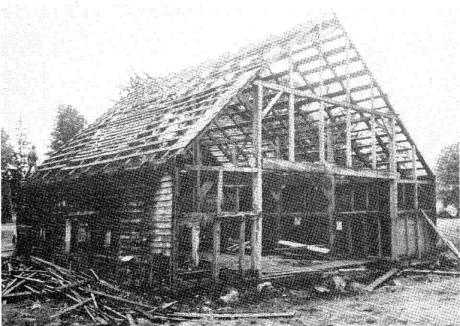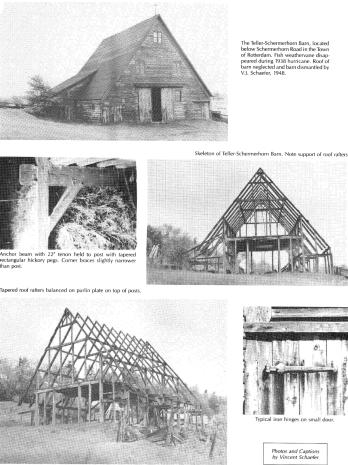|
Dutch
Barn Preservation Society
Dedicated
to the Study and Preservation
of New World Dutch Barns
NEWSLETTER,
SPRING 1998
Volume 1 Issue 1
Part TWO
INAUGURAL
ISSUE

North
end, Schaeffer-Ingold barn. The barn contained no evidence
of ever having a double wagon door in the north end. An addition,
removed, was previously attached to the north end of the barn.
The compass orientation of the ridge was NE to SW.
Research Finds
Seventeenth century "Dutch" barns began to be erected
soon after the arrival of Dutch and other North European settlers
of New Netherland. Some early contracts for the erection of Dutch
barns in the Hudson Valley have survived; these documents were
usually executed before a Notary Public and became part of his
record. Because contracts often were in Dutch, their translation
into English has posed technical problems with architectural terminology.
The following contract for a barn at Kinderhook called for a roof
with a clipped gable at each end. Unfortunately, no surviving barn
here exhibits this typically European feature. The "extension"
called for in the contract is the outside aisle for stock, making
the dimensions of the barn 50' by 46'. The "loft beam" could
be termed today an "anchorbeam." The translation was
done by Jonathan Pearson and was edited by A.J. Van Laer and published
in Early Records of Albany (1660-1696), Vol. 3, Albany,
1918, on pages 424 and 425.
Contract
of Harmen Bastiaesen to build a barn at Kinderhook for
Ian Maertensen:
On
this 8th day of February 1675 appeared before me, Adriaen
van Ilpendam, notary public residing in New Albany, and before
the afterwritten witnesses, Harmen Bastiaensz of the one
part, and }an Maertensz of the other part, who in love and
friendship are agreed in the manner following, to wit: Harmen
Bastiaensz acknowledges that he has undertaken to build for
}an Maertensz at Kinderhook a barn fifty feet long and twenty-six
feet wide, with an extension on each side, ten feet deep
and running the full length of the barn, and at each end
a gable with sloping peak; furthermore to make in said barn
five bents with five loft beams, of which five bents three
are to have brackets, a double door at the front end of the
barn and one door in each of the extensions, a horse manger
forty feet long and all the inside work that belongs to a
barn, except the floor, and properly to put on the rafters
of the roof. The contractor promises to begin to work thereon
next March of this year and not to stop before the work shall
be completed. The employer promises to furnish the contractor
with a man for one month to help rough-hew the timber; furthermore
the employer shall provide all the materials so that the
contractor shall not wait for them, and when the work is
completed, the employer promises to pay to the contractor
for the work done thirty-one good, whole, salable beaver
skins, or wheat or other wares at market price, with which,
if they suit him, the contractor is to be content: but on
condition that he shall give the contractor in hand three
mudde of wheat so soon as he begins the work, to be deducted
from the aforesaid stipulated sum, and furthermore pay the
half next harvest and the remainder next winter. . . . |
The Stabilization Of Barns
and Other Wooden Structures
By Harold Zoch
Existing wooden structures can continue to survive with some minor
effort on the part of the owner. Moisture is the prime destroyer
of wooden structures. The Dutch barn's design has aided its survival.
The design provides for the major load bearing members to be internal
to the structure. The outside walls, the ,most vulnerable, bear
a minor portion of the roof load. Despite this protection, some
barns are still lost to decay.
The key word in wooden structure survival is ventilation. Anything
that prevents ventilation or causes a need for ventilation will
eventually destroy the structure. The following suggestions will
improve the survivability of your wooden structure.
1. Repair roofs quickly. This is the most important requirement.
2. Remove brush and built-up material from around the edges
of barns. This will provide ventilation to the sills.
3. Most Dutch barns are built on piers - laid up short columns
of stone. Clean out around these areas to allow for airflow underneath
the floors.
4. Remove old hay and other unnecessary material from inside
the barn. This will, in addition to aiding ventilation, remove
a fire hazard.
5. Remove any superfluous wiring. If wire is needed, install
it using the appropriate wiring codes. This will usually require
containment of wiring and bulbs.
6. Once the sills are thoroughly dry consider the use of a
wood preservative.
Note: As a last step, the Dutch barn or other structure should
be recorded. Photos can be taken, sketches made, or a video camera
can be used. The need is to preserve as much information as possible
about the barn and site. Many barns are being destroyed by removal
from the site, fire and natural causes. The purpose of the recording
is to provide a historic record of the structure and its environs.
The Dutch Barn Preservation Society can assist you with the recording
needs for Dutch barns.
The
Teller Barn: A Rare Record of a Seventeenth Century Barn Dismantled
40 Years Ago.

|